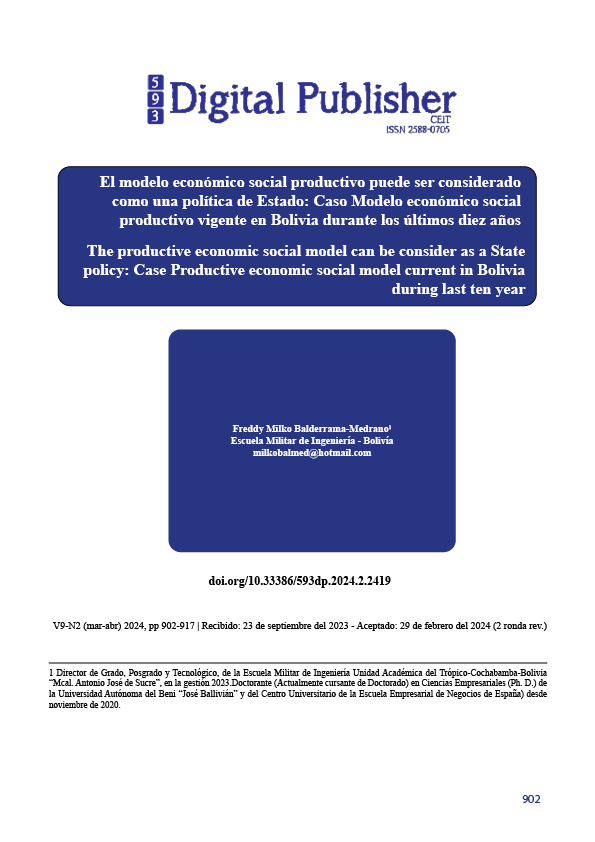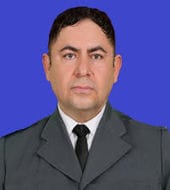The productive economic social model can be consider as a State policy: Case Productive economic social model current in Bolivia during last ten year
Main Article Content
Abstract
The model socio economic productive, had been setting during ten years in Bolivia, the main proposed it was get the obtain economic stability moreover the goal it reduce basically the high ratios poverty that imperacted in Bolivia, during the last ten years ago the mentioned model implemented in Bolivia, had reduced the level of poverty of the way significative even been studied international scientific societies in the economic field, in current Bolivia have not solid state policy because every time that change the government ( president), immediately issues chances the majority the plans that had made throughout his mandate, therefore there are not along serios State Policy in Bolivia jut only the are government plans, for get better the life level and image of state.
Downloads
Article Details

This work is licensed under a Creative Commons Attribution-NonCommercial-ShareAlike 4.0 International License.
1. Derechos de autor
Las obras que se publican en 593 Digital Publisher CEIT están sujetas a los siguientes términos:
1.1. 593 Digital Publisher CEIT, conserva los derechos patrimoniales (copyright) de las obras publicadas, favorece y permite la reutilización de las mismas bajo la licencia Licencia Creative Commons 4.0 de Reconocimiento-NoComercial-CompartirIgual 4.0, por lo cual se pueden copiar, usar, difundir, transmitir y exponer públicamente, siempre que:
1.1.a. Se cite la autoría y fuente original de su publicación (revista, editorial, URL).
1.1.b. No se usen para fines comerciales u onerosos.
1.1.c. Se mencione la existencia y especificaciones de esta licencia de uso.
References
America Economia. (12 de marzo de 2019). Economia. Obtenido de Bolivia: https://www.americaeconomia.com/economia-mercados/finanzas/pobreza-extrema-en-bolivia-disminuye-23-en-13-anos-y-alcanza-su-nivel-mas
Economia Plural. (2011). Modelo Socio Economico Comunitario y Productivo. La Paz: Ministerio de economia y finanzas de Bolivia.
Friedrich Ebert. (2009). La crisis economica global y su impacto sobre America Latina. La Paz: Fundación Friedrich Ebert.
INE. (7 de octubre de 2019). INE: La pobreza en Bolivia se ha reducido. Obtenido de Reducccion de la pobreza: https://www.ine.gob.bo/index.php/ine-la-pobreza-en-bolivia-se-ha-reducido/#:~:text=La%20pobreza%20extrema%20se%20redujo,07.10.19%20(INE).&text=De%20esta%20forma%2C%20se%20observar%C3%A1,pobreza%20en%20Bolivia%20est%C3%A1%20bajando.
Keynes, J. M. (1970). Teoria General. En J. M. Keynes, Teoria General (pág. 373). Mexico : Mc graw Hill.
Moreno, S. P. (6 de agosto de 2006). Analisis economico. Obtenido de Analisis economico: https://www.redalyc.org/pdf/413/41304804.pdf
Naciones Unidas. (2018). Erradicar la extrema pobreza y otras cuestiones de desarrollo. Asamblea 73 (pág. 14). Egipto: Naciones Unidas.
Paul Villarroel, W. H. (14 de noviembre de 2013). Evolution proverty. Obtenido de Evolucion de la pobreza: http://www.scielo.org.bo/pdf/rlde/n20/n20_a02.pdf
UDAPE. (2003). Estrategia Boliviana para reducir los niveles de pobreza . La Paz: UDAPE.


